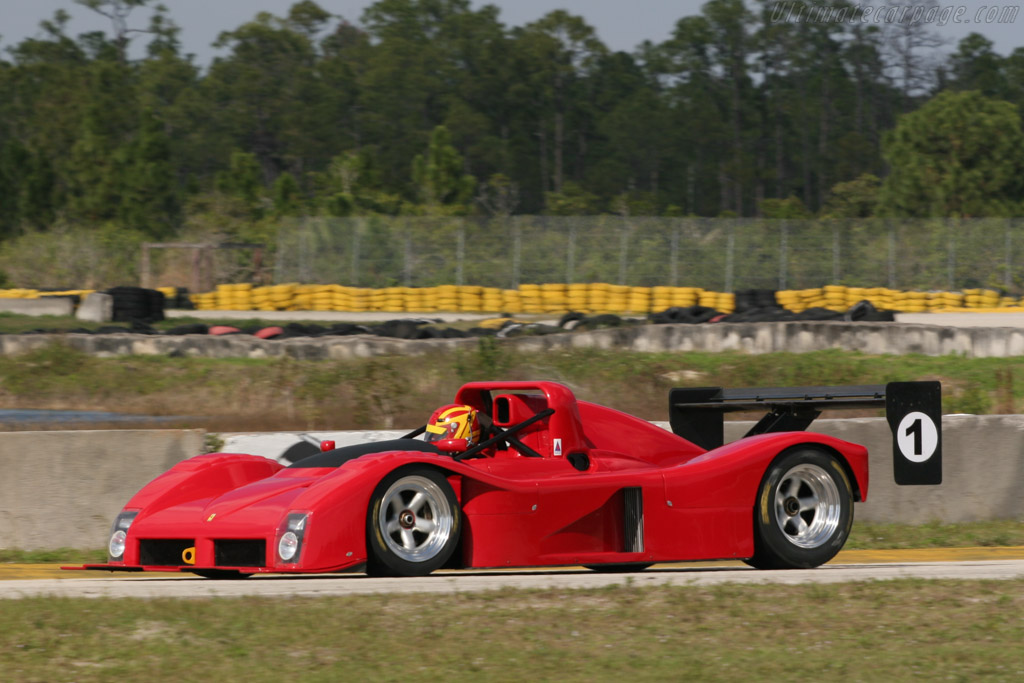
Model history:
Exactly 20 years after Ferrari last raced a sports prototype, the Maranello based firm surprised the world with the 333 SP in 1993. Jointly developed with Dallara, it was Ferrari's first new prototype racer in over two decades. Designed specifically for the new IMSA prototype regulations, the 333 SP was intended for customer racing only. The impulse for the project was given by Giampiero Moretti, founder of MOMO and Gian Luigi Buitoni, president of Ferrari North America. The program was nick-named 'Il Sogno Americano', the American Dream.
IMSA regulations specified that the engine used could not displace over four litres and had to be derived from a road car. The V12 used was similar in design to Ferrari's contemporary Formula 1 engines, but it was homologated because it would power the upcoming Ferrari F50 road car. For the F50 the 3.5 litre F1 engine was increased in size to 4.7 litre and then reduced again for the 333 SP. All technical aspects, like the 5 valves per cylinder setup, were retained for both the F50 and 333 SP engine. Like many of its legendary predecessors the 333 SP was named after its engine's unitary displacement of 333 cc.
Much of the design work for the chassis and body was done in Dallara's windtunnel. Following the regulations, the 333 SP featured a flat bottom chassis. Carbonfibre and other composites were used for the chassis and body, resulting in a very light but rigid monocoque construction. Double wishbones and push-rod operated coil springs/dampers were used all-round. The rolling chassis was not much different from the contemporary F1 designs, except for the increased width to accomodate a 'passenger.'
Completed, the 333 SP truely looked the part, a prototype more than worthy to bear the name Ferrari. Throughout its racing career, various modifications were made to the body, including a longer nose, but it did not loose its characteristic look. Apart from its looks and performance, it will be remembered best because of its sound. With a red line far beyond 10,000 rpm, the V12 produced a high pitched sound, pure all the way from idle to its maximum revolutions. On Spa Francorchamps it could be heard all around the 7 km track.
After thorough testing late in 1993, the 333 SP made its public debut at the Palm Beach Cavallino Classic in January of 1994. Three months later it made its racing debut at the Road Atlanta Sprint race. Ferrari's return to prototype racing was a return in style with a 1-2 finish in the first race and a stunning 1-2-3 finish in the next. Even though the cars were run by privateers only, three more victories were scored before end of the season. With a revised nose, the 333 SP was entered in the 1995 Sebring 12 Hours. A victory was had in this legendary race; the first Sebring win for the marque in 23 years.
More victories were scored, resulting in the IMSA driver's and manufacturer's championship in 1995. A natural progression would be an assault on the Le Mans 24 Hours. For long distance racing a special version was created with a larger fuel tank and a slightly detuned engine. In 1995, the only 333 SP entered had little success at Le Mans. A year later one of the 333 SPs entered qualified second and set the fastest lap in the race, only to retire after an accident. In 1997 a sixth place finish was scored. Le Mans remains as the only important endurance race not won by 333 SP in its lifetime.
After an already successful racing career, the best was yet to come in 1998. In the 1967 Daytona 24 Hours, Ferrari booked one of their most legendary victories, with the 1-2-3 finishing cars crossing the line side-by-side. With a further revised body and updated engine, the MOMO team entered the 333 SP in the 1998 running of the 24 Hours race. 31 Years after the legendary victory a Ferrari won the race again, it was also the marque's first 24-hours victory since the 1967 win. In the following years, the 333 SP was raced with considerable success both in Europe and in the US. The 2002 Daytona 24 Hours was the car's last official race, finishing off a very successful career that stretched over eight seasons.
The 333 SP's performance and great reliability record made it a popular pick among sportscar racers. By the end of its career, 40 examples were produced, an incredible amount for any prototype racer, let alone a Ferrari. The first 14 cars were constructed by Dallara, the next 26 by Michelotto. Many of them were later modified by the owners with revised sides, noses and wings to suit their particular needs, usually with help from Michelotto. In the final seasons some chassis were fitted with Judd engines, mostly for cost reasons.
source: http://www.ultimatecarpage.com/car/627/Ferrari-333-SP.html
by Wouter Melissen
| http://www.sfmotorsports.com |
No comments:
Post a Comment